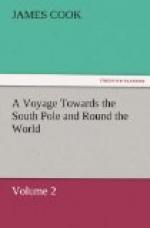The produce of this island is bread-fruit, plantains, cocoa-nuts, a fruit like a nectarine, yams, tarra, a sort of potatoe, sugar-cane, wild figs, a fruit like an orange, which is not eatable, and some other fruit and nuts whose names I have not. Nor have I any doubt that the nutmeg before mentioned was the produce of this island. The bread-fruit, cocoa-nuts, and plantains, are neither so plentiful nor so good as at Otaheite; on the other hand, sugar-canes and yams are not only in greater plenty, but of superior quality, and much larger. We got one of the latter which weighed fifty-six pounds, every ounce of which was good. Hogs did not seem to be scarce; but we saw not many fowls. These are the only domestic animals they have. Land-birds are not more numerous than at Otaheite, and the other islands; but we met with some small birds, with a very beautiful plumage, which we had never seen before. There is as great a variety of trees and plants here, as at any island we touched at, where our botanists had time to examine. I believe these people live chiefly on the produce of the land, and that the sea contributes but little to their subsistence. Whether this arises from the coast not abounding with fish, or from their being bad fishermen, I know not; both causes perhaps concur. I never saw any sort of fishing-tackle amongst them, nor any one out fishing, except on the shoals, or along the shores of the harbour, where they would watch to strike with a dart such fish as came within their reach; and in this they were expert. They seemed much to admire our catching fish with the seine; and, I believe, were not well pleased with it at last. I doubt not, they have other methods of catching fish besides striking them.
We understood that the little isle of Immer was chiefly inhabited by fishermen, and that the canoes we frequently saw pass, to and from that isle and the east point of the harbour, were fishing canoes. These canoes were of unequal sizes, some thirty feet long, two broad, and three deep; and they are composed of several pieces of wood clumsily sewed together with bandages. The joints are covered on the outside by a thin batten champered off at the edges, over which the bandages pass. They are navigated either by paddles or sails. The sail is lateen, extended to a yard and boom, and hoisted to a short mast. Some of the large canoes have two sails, and all of them outriggers.
At first we thought the people of this island, as well as those of Erromango, were a race between the natives of the Friendly Islands and those of Mallicollo; but a little acquaintance with them convinced us that they had little or no affinity to either, except it be in their hair, which is much like what the people of the latter island have. The general colours of it are black and brown, growing to a tolerable length, and very crisp and curly. They separate it into small locks, which they woold or cue round with the rind of a slender plant, down to about an inch of the




